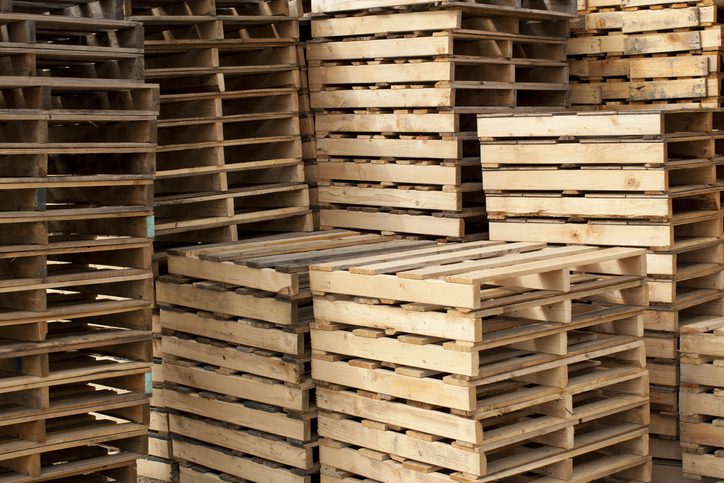The Eco-Friendly Choice: How Wood Pallets Promote Sustainability and Reduce Waste
The Eco-Friendly Choice: How Wood Pallets Promote Sustainability and Reduce Waste
Are you aware that the humble wood pallet, often overlooked and disregarded as a simple shipping tool, has the potential to be an eco-warrior in our quest for sustainability? In this blog post, we will unveil the hidden benefits of wood pallets and how they play a crucial role in reducing waste and promoting a greener future. From their renewable source to their recyclability, join us on this journey as we explore why choosing wood pallets is not only smart but also an environmentally friendly choice. Get ready to be amazed at just how much impact these unassuming wooden platforms can have on our planet’s well-being!
Introduction to the use of wood pallets
Introduction to the use of wood pallets:
Wood pallets have been used for decades as a means of transporting goods and materials. They are a popular choice among businesses and industries due to their durability, affordability, and versatility. However, in recent years, wood pallets have gained even more attention for their eco-friendly properties.
In this section, we will explore the basics of wood pallets – what they are, how they are made, and why they are a sustainable option for businesses. Whether you are new to the world of wood pallets or looking for more information on their environmental benefits, this introduction will provide you with all the necessary knowledge.
What are wood pallets?
Wood pallets are flat structures made from wooden boards that support goods during transport and storage. They come in various sizes and designs depending on the type of product being transported and the machinery used to move them. The most common types of wood used for making pallets include pine, oak, birch, cedar, and spruce.
How are they made?
The process of making wood pallets is relatively simple yet requires skillful craftsmanship. It begins with sourcing high-quality lumber from sustainably managed forests. Once the wood is harvested, it goes through a series of cutting and shaping processes using sawmills or automated machines.
The environmental impact of traditional pallets
Introduction:
Wood pallets, also known as wooden shipping platforms, have been the go-to choice for transporting goods and products for decades. However, with the increasing focus on environmental sustainability and reducing waste, it is important to consider the impact of traditional pallets on our planet. In this section, we will discuss the environmental impact of traditional pallets and how they contribute to sustainable practices.
1. Deforestation:
One of the main concerns surrounding traditional wood pallets is deforestation. These pallets are made from trees that are cut down specifically for this purpose. This leads to a depletion of natural resources and loss of habitat for wildlife. According to a report by The Balance Small Business, around 50% of all hardwood harvested in the United States is used for making wooden pallets.
2. Carbon footprint:
The production process of traditional wood pallets involves cutting down trees, processing the wood, and transporting them to different locations. This results in a high carbon footprint due to the use of heavy machinery and transportation vehicles emitting harmful gases into the atmosphere.
3. Chemical treatments:
To increase their durability and prevent damage from insects or fungi, traditional wood pallets are often treated with chemicals such as methyl bromide or heat-treated using kilns. These treatments can release harmful toxins into the environment and pose a risk to workers who handle them.
Benefits of using wood pallets for sustainability
Wood pallets have been a staple in the shipping and logistics industry for decades. They provide a sturdy and cost-effective way to transport goods from one place to another. However, aside from being useful in the supply chain, wood pallets also offer numerous benefits when it comes to sustainability.
In recent years, there has been a growing concern about environmental sustainability and reducing waste. This is where wooden pallets prove to be an eco-friendly choice compared to other materials such as plastic or metal.
1. Renewable Resource
One of the biggest advantages of using wood pallets is that they are made from renewable resources. Wood is a natural material that can be replenished through sustainable forestry practices. This means that even if we use wood for making pallets, new trees can be planted to replace them.
On the other hand, plastic and metal are non-renewable resources which require significant amounts of energy and resources to produce. By opting for wood pallets, we contribute towards preserving our natural resources for future generations.
2. Biodegradable
Another important factor when it comes to sustainability is how easily a material can decompose at the end of its lifecycle. Wooden pallets are biodegradable, meaning they will break down over time without causing any harm to the environment.
– Renewable resource
Renewable resources refer to natural resources that can be replenished or renewed over time, either through natural processes or human intervention. These resources are crucial for promoting sustainability and reducing waste as they provide an alternative to finite resources that may eventually run out.
Wood pallets are a prime example of a renewable resource that has gained popularity in recent years due to its eco-friendly properties. As the demand for sustainable packaging and transportation solutions continues to rise, the use of wood pallets has become a preferred choice for many businesses.
One of the main reasons why wood pallets are considered renewable is because they are made from timber which is a natural and renewable material. Trees used for making wood pallets can be grown and harvested in a sustainable manner, ensuring that there is no depletion of forests. Moreover, timber production promotes forest growth through reforestation efforts, making it an environmentally friendly choice.
In addition to being made from renewable materials, wood pallets also have a long lifespan compared to other packaging materials. They can be reused multiple times before reaching the end of their useful life. This not only reduces waste but also lowers the need for producing new pallets, thereby conserving energy and raw materials.
Furthermore, when wood pallets reach the end of their useful life, they can be recycled into other wooden products such as furniture or mulch instead of ending up in landfills. This helps in diverting waste from landfills and reduces the overall environmental impact.
– Biodegradable and recyclable
As concerns about environmental sustainability continue to rise, businesses and individuals are searching for new ways to reduce waste and promote eco-friendly practices. One simple yet effective solution is the use of wood pallets, which are both biodegradable and recyclable.
Biodegradability refers to the ability of a material to break down naturally without causing harm to the environment. Wood pallets are made from natural materials such as pine, cedar, or oak trees, and do not contain any harmful chemicals or additives. This means that when they reach the end of their life cycle, they can be easily broken down by microorganisms in soil or water, leaving behind only natural components.
In contrast, many other shipping and storage options such as plastic or metal pallets take hundreds of years to decompose and often release toxic chemicals into the environment during this process. By choosing wood pallets, you can significantly reduce your carbon footprint and contribute to a healthier planet.
Not only are wood pallets biodegradable, but they are also highly recyclable. In fact, over 95% of all wooden packaging materials are recycled in some way after use. This includes being repurposed into mulch for gardening or as fuel for energy production. Recycling wood pallets helps prevent unnecessary deforestation and reduces the amount of waste sent to landfills.
Additionally, wooden pallets have a long lifespan and can be reused multiple times before needing replacement. This makes them a sustainable choice that promotes circular economy principles by reducing overall resource consumption.
– Reduces waste in landfills
One of the major benefits of using wood pallets is their ability to contribute to reducing waste in landfills. Landfills are a growing environmental concern, with millions of tons of waste being dumped into them every year. This not only takes up valuable space but also poses a threat to the environment and human health.
Wood pallets help reduce this issue by providing an eco-friendly alternative for packaging and shipping goods. Unlike plastic or metal pallets, which often end up in landfills due to their non-biodegradable nature, wood pallets can be easily recycled and repurposed.
One way that wood pallets reduce waste in landfills is through their durability and longevity. Wood is a strong and sturdy material that can withstand the wear and tear of transportation and storage without breaking down easily. This means that wood pallets have a longer lifespan compared to other types of packaging materials, reducing the need for frequent replacements.
Furthermore, when wood pallets do reach the end of their useful life, they can be easily repaired or recycled into new products such as furniture or mulch. In fact, according to the Environmental Protection Agency (EPA), approximately 95% of wooden pallets are reused or recycled rather than disposed of in landfills.
Innovative ways to reuse and repurpose wood pallets
When it comes to sustainability and reducing waste, one often overlooked solution is wood pallets. These versatile structures are commonly used in the shipping and logistics industry to transport goods, but they can also be repurposed in a variety of creative ways. In this section, we’ll explore some of the most innovative and eco-friendly ways to reuse and repurpose wood pallets.
1. Furniture
One of the most popular uses for old wood pallets is creating unique and stylish furniture pieces. With a little bit of creativity and DIY know-how, you can turn these simple structures into everything from coffee tables and bookshelves to outdoor seating and bed frames. Not only does this save money on buying new furniture, but it also helps reduce the demand for newly manufactured products.
2. Vertical Gardens
In urban areas with limited space for gardens, vertical gardens have become increasingly popular. And what better way to create one than by using old wood pallets? By attaching planter boxes or pots to the slats of the pallet, you can easily transform it into a beautiful vertical garden that not only adds greenery to your space but also helps purify the air.
3. Compost Bins
For those looking to reduce their carbon footprint, composting is an excellent way to turn food scraps and other organic waste into nutrient-rich soil for gardening. Wood pallets make perfect compost bins as they allow for proper airflow while containing all the materials in one place.
– Furniture and home decor ideas
Furniture and home decor are essential elements of any living space, but they can also have a significant impact on the environment. This is where wood pallets come in as an excellent eco-friendly choice for furnishing and decorating your home. These versatile and sustainable materials not only reduce waste but also promote sustainability in various ways.
1. Upcycling Potential:
Wood pallets are often discarded after being used to transport goods or materials, leading to a large amount of waste. However, these pallets can be repurposed and upcycled into various furniture pieces and home decor items such as tables, shelves, bed frames, wall art, and more. By using wood pallets for your furniture needs, you are giving them a new life instead of adding to the already overflowing landfills.
2. Sustainable Material:
Wood pallets are mainly made from natural materials such as pine or oak wood that is sourced from sustainably managed forests. This means that the production process has minimal impact on the environment compared to other materials like plastic or metal. Moreover, since these woods come from renewable sources, it reduces deforestation and promotes forest regrowth.
3. Reduced Energy Consumption:
The manufacturing process of wood pallets requires less energy compared to other materials like plastic or metal. The energy used in producing one wooden pallet is significantly lower than that needed for a plastic or metal counterpart of similar strength and durability. This reduction in energy consumption helps in lowering carbon emissions and promoting sustainable practices.
– Garden and outdoor projects
Garden and outdoor projects are a great way to add beauty and functionality to your outdoor space while also promoting sustainability. And what better way to achieve this than by using wood pallets? These versatile pieces of reclaimed wood have become increasingly popular among DIY enthusiasts for their eco-friendly qualities. In this section, we will explore how wood pallets can be used in various garden and outdoor projects, making them an excellent choice for those looking to reduce waste and promote sustainability.
1. Garden Planters
One of the most common uses of wood pallets in gardening is creating planters. These can be easily made by dismantling the pallets, removing any nails or staples, and reassembling the planks into a box shape. This simple project not only adds a rustic charm to your garden but also helps reduce waste by repurposing old materials. Additionally, wooden planters allow for better drainage, preventing water from pooling at the bottom and causing root rot.
2. Composting Bins
Composting is an essential part of sustainable living as it reduces waste while providing nutrient-rich soil for plants. Wood pallets make excellent composting bins as they are easy to assemble and provide adequate ventilation for the composting process. You can either create a single bin or stack multiple pallets on top of each other for larger composting needs.
– Business and industrial uses
Wood pallets are a ubiquitous sight in the business and industrial world, used for transporting goods and materials on a daily basis. However, many may not realize that these seemingly simple structures can have a significant impact on promoting sustainability and reducing waste.
Firstly, wood pallets are a renewable resource. Unlike plastic or metal pallets which require non-renewable resources to produce, wood is a natural material that can be sustainably harvested from forests. This means that as long as responsible forestry practices are followed, the supply of wood for pallet production will never run out.
In comparison to other types of pallets, wood also has a lower carbon footprint. The manufacturing process for plastic or metal pallets often involves large amounts of energy consumption and emissions. Wood pallets, on the other hand, have a much simpler production process and require significantly less energy to manufacture.
Wooden pallets are also incredibly durable and long-lasting. They can withstand heavy loads without breaking or warping easily, making them ideal for use in busy industrial settings. This durability means that wood pallets have a longer lifespan compared to other types of packaging materials such as cardboard boxes or plastic wrap. As a result, businesses can save money by reusing wooden pallets multiple times instead of constantly purchasing new packaging materials.
Tips for sourcing sustainable wood pallets
Wood pallets are an essential part of the supply chain and logistics industry, used for storing and transporting goods all over the world. However, with the increasing concern for environmental sustainability, it is crucial to consider the source of these pallets. Many people may not be aware that sourcing sustainable wood pallets can have a significant impact on reducing waste and promoting sustainability.
In this section, we will discuss some tips for sourcing sustainable wood pallets to help you make more environmentally friendly choices in your business.
1. Choose Reusable Pallets: The most sustainable option when it comes to wood pallets is to opt for reusable ones. These are typically made from higher quality materials and can be used multiple times before being recycled or disposed of. By choosing reusable pallets, you can significantly reduce the amount of waste generated in your supply chain.
2. Look For Certifications: When sourcing wood pallets, always look for certifications that ensure they come from sustainably managed forests. Some commonly recognized certifications include Forest Stewardship Council (FSC) and Sustainable Forestry Initiative (SFI). These certifications guarantee that the wood used to make the pallets is sourced responsibly without causing harm to the environment.
3. Consider Recycled Pallets: Another eco-friendly option is to choose recycled wood pallets. These are made from reclaimed lumber or scrap materials from other industries like construction or furniture manufacturing. Using recycled materials helps reduce demand for new resources and minimizes waste going into landfills.
Challenges and solutions
Challenges and Solutions:
While wood pallets may seem like a simple and eco-friendly choice on the surface, there are still challenges that need to be addressed in order to fully promote sustainability and reduce waste. In this section, we will discuss some of the common challenges associated with wood pallets and provide solutions for overcoming them.
1. Limited lifespan:
One of the main challenges with wood pallets is their limited lifespan. Due to constant use and exposure to various environments, wood pallets can become damaged or worn out over time. This can result in frequent replacements, leading to increased waste.
Solution: To combat this issue, companies can opt for using durable hardwood or heat-treated lumber for their pallets. These materials are stronger and more resistant to damage, extending the lifespan of the pallets. Additionally, implementing proper maintenance procedures such as regular inspections and repairs can also help prolong the life of wood pallets.
2. Transportation emissions:
Transporting goods using wooden pallets can also contribute to carbon emissions and air pollution if not done efficiently. The weight of wooden pallets adds additional load onto transportation vehicles which require more fuel consumption.
Solution: To tackle this challenge, businesses can explore alternative modes of transportation such as rail or waterways which have lower carbon footprints compared to road transport. Another solution is optimizing cargo loads by using stackable or collapsible wooden pallet designs that take up less space during transport.








Comments are closed.